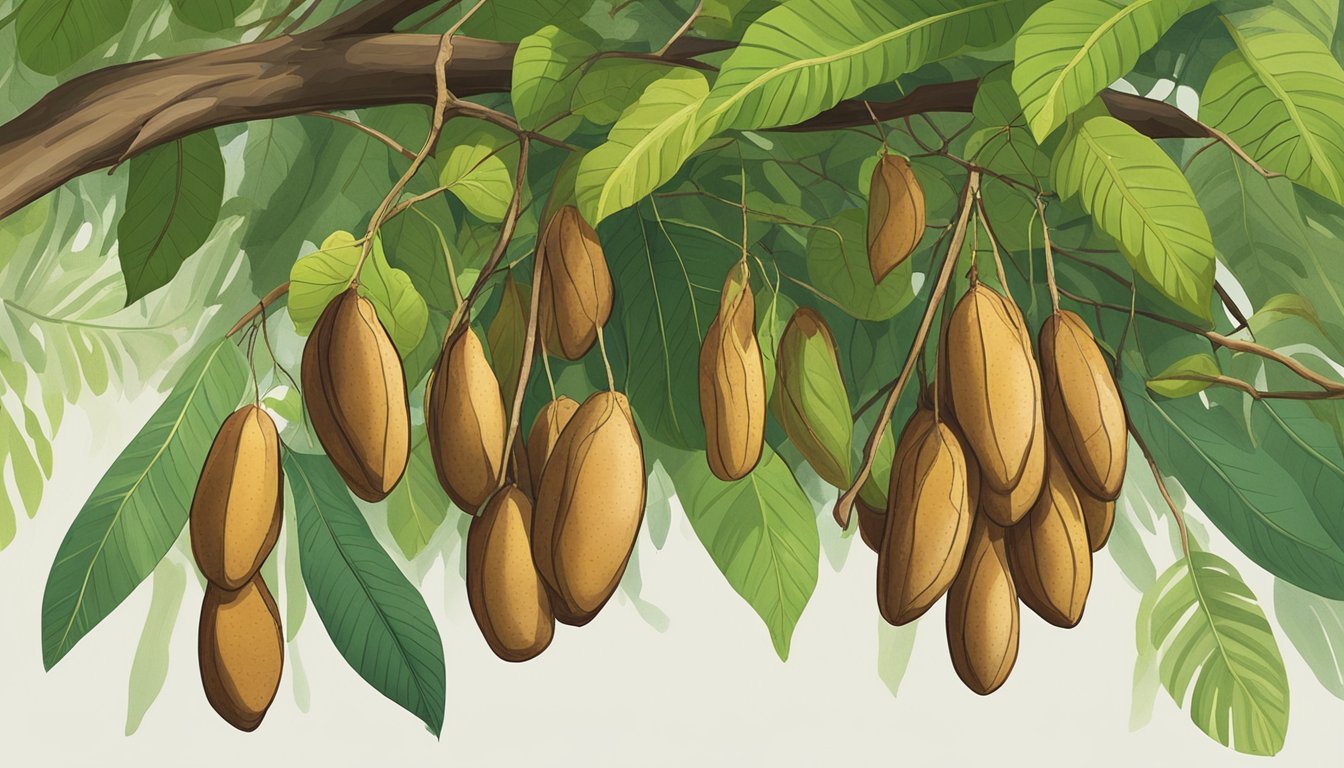How to Tell if Tamarinds Are Ripe
Expert Tips for Perfect Selection
Tamarind, a tart and delectable fruit, is extensively used in cuisines around the world for its unique flavor profile. It's an essential ingredient in many cultural dishes, from chutneys and marinades in Indian cooking to the tangy pulp used in Mexican candies. Knowing when a tamarind is ripe is crucial for its culinary use, as the ripeness affects both the fruit's flavor and texture. Ripe tamarind should feel soft and pliable and possess a brown shell that easily cracks to reveal the sticky, dark flesh within.
Unripe tamarind is often sour and less sweet, while the ripe fruit provides a perfect balance of sweetness and acidity that enhances its versatility in cooking. This ripeness not only maximizes the fruit's natural gustatory appeal but also makes it easier to convert into pastes and concentrates that form the backbone of many recipes. Observing color changes, feeling for a certain softness, and checking for a sticky residue are helpful methods to judge the maturity of the fruit. For those looking to harness the vibrant flavors of this tropical fruit, recognizing the signs of ripeness is a vital skill in both selection and usage.
Key Takeaways
Ripe tamarind is distinguished by its soft texture, sweet and tangy flavor, and a brown, crackable shell.
The ripeness of tamarind influences its culinary application, ranging from pastes to flavoring agents.
Recognizing a ripe tamarind involves checking color, softness, and stickiness.
Identifying Ripe Tamarinds
When it comes to identifying ripe tamarinds, there are a few key indicators that one needs to be aware of. The color, texture, and taste offer clear signals of the fruit's ripeness.
Visual Inspection
One can determine the ripeness of tamarind pods by closely examining their appearance. Ripe tamarind pods typically exhibit a dark brown color. In contrast, unripe tamarinds are green and transition through a yellow-brown phase before reaching full maturity. The dark brown hue signifies the tamarind is ready for consumption or culinary use.
Texture and Firmness
The ripe tamarind's outer shell should feel brittle and easy to crack, a feature that distinguishes it from the harder shells of unripe tamarinds. The inner flesh should be slightly sticky to the touch—an indicator of the natural sugars present in ripe tamarind. One can gently press the pod with their fingers to test for a yielding but not overly mushy consistency.
Tasting Notes
When it comes to taste, a ripe tamarind pod offers a complex profile, balancing sweet and sour flavors. If someone tastes the tamarind and notes an intense tartness, this generally suggests that the pod is not quite ripe. A fully mature tamarind carries a more subdued acidity, alongside a caramel-like sweetness that deepens and enriches the overall flavor profile. Sampling a small piece of the tamarind's flesh can confirm its readiness for use in dishes or consumption.
Tamarind Varieties and Ripeness
Tamarind is a fruit known for its distinctive sweet and sour flavor, widely used as a souring agent in various cuisines across Asia, Africa, and India. There are multiple varieties, but among the most popular is the Sweet Tamarind, which is particularly cherished in Indian dishes to create a tangy-sweet seasoning or chutney.
When ripe, Sweet Tamarind has a flavor profile that leans more towards sweetness with a tangy undertone. The ripeness of tamarind can be gauged by its pod color and texture. Typically, a tamarind pod transitions from green to a brown or reddish-brown hue as it ripens. A ripe tamarind pod will also feel brittle and dry to the touch, and the flesh inside will be sticky and dark brown.
Here's a brief guide to identify ripe tamarinds:
Pod Color: Green
Texture: Firm
Flavor: Sour (Indicates unripe tamarind)
Pod Color: Brown
Texture: Brittle
Flavor: Balanced sweet and sour (Indicates ripeness)
Pod Color: Dark Brown
Texture: Very Dry
Flavor: More sweet, less sour (Overripe)
To test ripeness, one can also pressure the pod gently with their fingers. If the shell cracks easily to reveal the sticky pulp inside, this is an indicator of ripeness.
In summary, when seeking ripe tamarinds for culinary use, one should look for pods that have a brown or reddish-brown shell, are dry and brittle to the touch, and contain dark brown, sticky pulp. This fruit, when ripe, serves as an ideal balance of sweetness and sourness to complement various dishes across different cultures.
Harvesting and Storing Tamarinds
When harvesting tamarinds, one must look for pods that have turned a deep brown. Such a color is typically an indicator of ripeness. The pods should show slight cracks, and they might be removed with sharp tools like pruning shears, cut close to the stem to preserve the integrity of the fruit.
After harvesting, tamarinds have a limited shelf life at room temperature, peaking in flavor within the first seven days. The whole pods can be kept on the countertop if they are not yet open, as the shell offers natural protection for a few days.
For prolonged storage, consider these methods:
Storage Type: Unopened Block
Method: Store in a cool, dry place away from sunlight
Shelf Life: Up to 1 year
Storage Type: Opened Block
Method: Wrap in plastic without air gaps, refrigerate
Shelf Life: 3-4 months
Storage Type: Tamarind Paste/Chutney
Method: Seal in an airtight container, refrigerate
Shelf Life: Duration may vary
To assess if a tamarind has gone stale, check for hardness or brittleness in the flesh. If either is detected, it's best to discard the tamarind as it may no longer be ripe or palatable. In a fridge, the tamarind's longevity increases significantly. By storing the tamarind within an airtight container, one can minimize exposure to air and moisture, which are principal factors in the degradation of the fruit.
Uses of Ripe Tamarind in Cooking
Ripe tamarind is a versatile ingredient used extensively in Asian cuisine, particularly in Indian and Thai dishes. The pulp extracted from ripe tamarind pods imparts a distinctly sweet and sour flavor, making it a valuable component in a variety of recipes.
Sauces:
Tamarind paste: Used as a base for sauces, often combined with other ingredients like sugar and spices.
Dipping sauces: Frequently found in Indian and Thai cuisine, it adds tanginess to sauces served with snacks and appetizers.
Curries:
Indian cooking: Tamarind pulp is a common souring agent in dishes like Sambar, a lentil-based vegetable stew.
Thai dishes: Often integrated into curry recipes to balance the heat with its sourness.
Chutney:
Tamarind chutney is a popular Indian condiment prepared with tamarind pulp, sugar, and various spices. It accompanies everything from rice to bread and snacks.
Marinades:
Tamarind is used to marinate meat, imparting a tart flavor that enhances tenderness.
Dressings and Drinks:
Salad dressings and refreshing beverages frequently utilize tamarind to add a zesty twist.
Desserts (What wine goes well with desserts?):
In some cultures, tamarind pulp finds its way into sweet creations, adding complexity to the dessert's flavor profile.
By incorporating ripe tamarind into these culinary applications, chefs and home cooks alike can achieve a balance of sweetness and sourness that is essential to many Asian dishes. Its unique taste complements a wide range of ingredients, establishing ripe tamarind pulp as a staple in diverse cooking traditions.
Preparation Techniques for Tamarind
When preparing tamarind, one aims to extract the pulp from the pods to make tamarind paste. The process is fairly straightforward, ensuring that one can use the flavorful ingredient in various recipes. They should start by selecting ripe tamarind pods; these are typically brown and have a shell that cracks easily, revealing the sticky pulp inside. The pods should feel heavy for their size, indicating a good amount of pulp within.
Making Tamarind Paste
Pod Preparation: Begin by shelling the ripe tamarind pods and removing any strings.
Pulp Removal: Extract the sticky pulp from the pods.
Seeding: Carefully remove the hard seeds from the pulp.
Extracting the Juice
Soaking: Place the tamarind pulp in a bowl, covering it with boiling water. Let it soak until the mixture softens.
Straining: After soaking, use hands or a spoon to knead the pulp, helping to separate it from the fibers. Strain the mixture into another bowl.
Quantity: For every cup of tamarind pulp, use 1 ½ cups of boiling water.
Duration: Soak the tamarind pulp for about 30 minutes to 1 hour.
Note: For a thinner paste, more water may be added.
Finalizing the Paste: The result should be a smooth, thick paste. Adjust the consistency by adding more water if necessary. It is usable in various recipes, ranging from pad thai to Indian curries, as it adds a distinctly sour flavor.
To store the tamarind paste, they can keep it in a sealed container in the refrigerator, where it will remain good for several weeks. If someone prefers a longer shelf life, freezing the paste in ice cube trays is an option, providing convenient, ready-to-use tamarind portions for future cooking endeavors.
Tamarind-Based Recipes
Tamarind fruit is integral to various cuisines and is used to prepare an array of delicious recipes. When ripe, tamarind provides a perfect balance of sweet and sour, often used as a base for sauces and condiments.
Tamarind Concentrate: Chefs often use tamarind concentrate to add depth to dishes. This concentrate can be made by soaking the tamarind pulp in hot water, straining it to remove seeds and fibers, and then reducing the liquid until thickened.
Pad Thai: A staple in Thai cuisine, pad thai often includes tamarind concentrate in its sauce, providing the characteristic tangy flavor that complements the dish's savory and sweet notes.
Worcestershire Sauce: This complex sauce integrates a variety of ingredients, where tamarind extract serves as a key component contributing to its unique taste.
Tamarind Chutney: An Indian delicacy, tamarind chutney, also known as 'imli ki chutney', combines tamarind with sweet jaggery and a mix of spices. It's commonly served with snacks like samosas.
Curry: Tamarind is also used to give curries a tangy flavor profile. Either the pulp or concentrate can be incorporated into curry bases to introduce acidity, which balances the richness of the dish.
Chefs incorporate tamarind in various other recipes to create dishes that sing with a harmonious blend of sweet and sour.
Recipe Type: Sauces
Use of Tamarind: As a base for a tangy element
Recipe Type: Soups
Use of Tamarind: To add a sour note
Recipe Type: Marinades
Use of Tamarind: To tenderize and flavor meat
Recipe Type: Desserts
Use of Tamarind: In candies and sweet treats
By understanding how to utilize tamarind effectively in recipes, cooks can harness the fruit's full potential to enhance their culinary creations.
Health Benefits and Nutritional Value
Tamarinds are celebrated for their impressive nutritional profile and associated health benefits. This fruit is an excellent source of antioxidants, which are vital in protecting the body from free radicals, known to cause oxidative stress and potentially contribute to chronic diseases.
In terms of minerals, tamarind is a good source of magnesium, an essential nutrient that supports over 300 biochemical reactions in the body, including muscle and nerve function, as well as energy production. Reliable intake of magnesium is also implicated in maintaining heart health and strong bones.
Iron is another important mineral found in tamarind, essential for the formation of hemoglobin in the blood and fundamental in preventing anemia. Consuming tamarinds can contribute to meeting one's daily iron requirements.
Fiber is abundant in tamarind, with its fibrous pulp aiding digestion and promoting a feeling of fullness. High fiber intake is linked to several health benefits, including lower blood sugar levels and improved gastrointestinal health.
Tamarind also offers a range of vitamins, particularly B vitamins such as thiamine and folate, which are critical in supporting the body's energy production and cell division processes. However, it's important to note that tamarind does not contain vitamin B12, which is typically sourced from animal products or supplements.
Potassium, a mineral in tamarind, helps control heart rate and blood pressure, providing a protective effect against stroke and coronary heart disease.
Nutrient: Antioxidants
Benefit: Protects cells from oxidative damage
Nutrient: Iron
Benefit: Essential for blood formation and oxygen transport
Nutrient: Fiber
Benefit: Aids digestion and blood sugar control
Nutrient: B Vitamins
Benefit: Important for energy production and cell health
Nutrient: Potassium
Benefit: Regulates heart rate and blood pressure
Nutrient: Magnesium
Benefit: Supports muscle, nerve function, and bone health
By including tamarinds in one's diet, individuals can enjoy these health benefits while also adding a unique flavor to their meals.
Substitutes for Tamarind
In recipes where tamarind is a key ingredient for its distinctive sour flavor, there are several substitutes one can resort to if this fruit is unavailable. Each substitute brings a slightly different flavor profile and should be used depending on the desired outcome of the dish.
Lime Juice and Brown Sugar:
A combination of lime juice and brown sugar can mimic the sour and sweet taste of tamarind.
Substitute: Lime Juice + Brown Sugar
Proportion: 1:1 ratio
Notes: Mix equal parts to substitute tamarind paste.
Vinegar-Based Substitutes:
Vinegar can serve as a souring agent in the absence of tamarind.
Substitute: Balsamic Vinegar
Proportion: Start with small amounts
Notes: Gradually add to achieve the desired sourness.
Substitute: Worcestershire Sauce
Proportion: According to taste
Notes: Contains vinegar for sourness and additional complex flavors.
Molasses:
For a deeper sweet note similar to tamarind’s sweetness, molasses can be a suitable alternative, especially when paired with a souring agent like vinegar.
Tamarind Juice Substitute:
If tamarind juice is the requirement, one might combine other sour liquids like lime juice or vinegar with a sweetener to replicate both the sourness and sweetness.
It is essential to keep in mind that these substitutes might alter the flavor of the dish marginally. They should be added incrementally while tasting to ensure that the balance of sour and sweet achieves a harmonious flavor akin to that of tamarind.
Cultural Significance of Tamarind
The tamarind tree, native to Africa, has since threaded its way deeply into the cultural fabric of various regions around the globe, including India, Southeast Asia, Central and South America, and the Middle East.
In Indian cuisine, it's revered not only for its culinary contributions but also for its role in local economies, particularly within tribal communities. Known colloquially as the "date of India," tamarind's tangy flavor characterizes many Indian dishes, making it a staple in kitchens and an essential component of the country's gastronomic heritage.
In Southeast Asia, the tart fruit is frequently used in cooking, adding a unique sour taste to many traditional dishes. The tree's resilience and versatility ensure its prominence within both domestic and commercial spheres.
Tamarind's influence extends to Central and South America where it was introduced through Spanish and Portuguese colonization. Today, it is a common ingredient in beverages, desserts, and savory dishes, signifying its seamless integration into the New World's cuisine.
The Middle East appreciates tamarind for its flavor and medicinal properties, as seen in its inclusion in various recipes and its use in traditional remedies. Its integration in the Middle Eastern diet can be traced historically through trade routes.
Despite its widespread culinary use, in regions like Africa and the Middle East, the tamarind tree also carries strong cultural symbolism. In some cultures, the tree represents faithfulness and resilience, mirroring the enduring nature of the tree itself, which thrives in hot climates and can grow to significant heights.
Conclusion
Ripe tamarind is essential for the best culinary results. It should have a rich brown color and feel slightly sticky when handled. The shell of the tamarind pod is an indicator of ripeness, with a brittle exterior that cracks easily suggesting maturity. Inside, the pulp must be dark brown, not black or discolored, a sign freshness has been retained.
Storage practices affect tamarind's longevity. Refrigeration is recommended for fresh tamarind, which can be stored in a zip-lock bag or airtight container for up to two weeks. For extended use, converting tamarind into paste and sealing it in jars substantially extends its shelf life.
One should check for mold, off-putting sour smells, or discolored flesh to confirm if the tamarind has spoiled. In the presence of these signs, it is advised to discard the fruit to prevent any health issues.
In summary, selecting and storing tamarind correctly ensures that its tangy flavor and nutritional benefits can be fully utilized in various recipes. By adhering to the guidelines for ripeness and storage, cooks and consumers can comfortably rely on the quality of this versatile ingredient.






